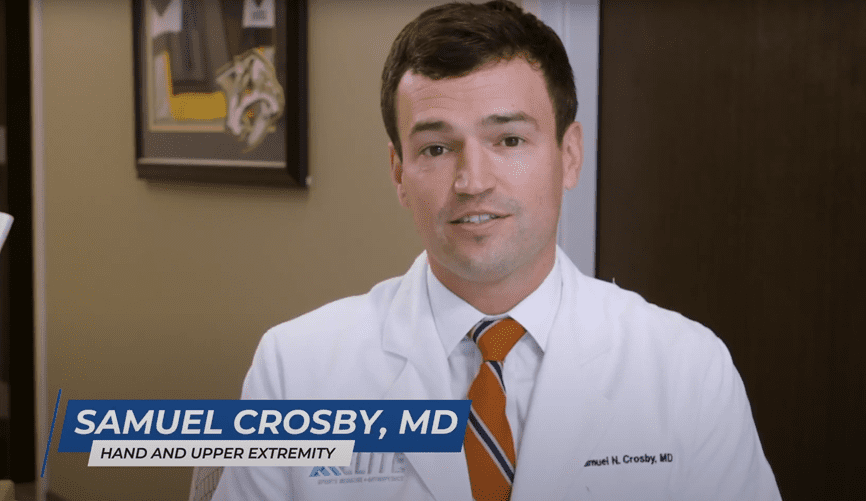
Sprained ankles are the most common sports-related injury and a familair injury to foot doctors, with an estimated 25,000 occurances each day. Sprained ankles account for 45% of all basketball injuries, 31% of soccer injuries and also frequently occur in football players, gymnasts, and runners. We dive into how our foot doctors in Nashville, TN identify and treat sprained ankles.
If you think you may have suffered an ankle sprain after reading this article, you should schedule an appointment with a foot doctor near you.
Identifying an Ankle Sprain
So what exactly is an ankle sprain, what do you do for it, and when should you be concerned?
It’s easier to understand ankle sprains if you are familiar with the basic anatomy in the foot and ankle: the three main bones that comprise the joint are the talus (in the foot), tibia and fibula (in the leg). Basically, it is a hinge joint that connects the leg and foot. The primary ligaments of the ankle include the lateral ligament, deltoid ligament, and the syndesmosis.
The lateral ligament is the most commonly injured in an ankle sprain so we will go into a few more details about it. It is comprised of three components: the anterior talofibular ligament (ATFL), the calcaneofibular ligament (CFL), and the posterior talofibular ligament (PTFL). These structures help maintain the stability of the ankle.
An ankle sprain usually occurs secondary to an inversion injury. An example is a basketball player jumping up for a rebound and, upon landing, steps on an opponent’s foot and “rolls the ankle”. Often, a “pop” is either heard or felt. Initially there can be swelling and bruising (which can be impressive). With severe sprains, there can be difficulty with weight bearing on the affected side.
Treating an Ankle Sprain
When you come into the office for an ankle sprain, we look for significant lateral ankle swelling along with bruising that can extend all the way down the foot and into the toes.
There is usually tenderness over the lateral ligament, and with severe sprains over the deltoid ligament and syndesmosis as well. We commonly obtain radiographs (x-rays) of the ankle at the first clinic visit to assess whether or not any associated ankle injury was sustained. For acute ankle sprains, further imaging (such as MRI) is not necessary, as it does not alter the treatment plan.
In case of more severe sprains, treatment involves short term immobilization in a walking boot for comfort and to more rapidly promote healing. However, in simple sprains, a boot is not needed and an ankle brace alone provides sufficient protection and stability.
Physical therapy is initiated once the patient’s acute pain and swelling subside. The physical therapist works on stretching, proprioception, and strengthening at each session. As the patient progresses, the physical therapist will begin to work on more sports specific training; when this can be done without pain, the athlete is ready to return to play. This can take anywhere from 2-8 weeks depending on the severity of the sprain. We recommend continuing to use a brace during athletic training and competition to avoid re-injury.
Fortunately, most ankle sprains fully heal when proper treatment is initiated; however, there are circumstances in which an ankle sprain doesn’t progress as anticipated. In such cases, further imaging and surgical intervention may be warranted.
Elite has two incredibly gifted orthopedic surgeons that we consider to be the best foot doctors in Nashville, TN. If you live in the Nashville or Franklin, TN area, we recommend visiting Dr. Jeffrey Willers or Dr. Brian Thomson if your foot and ankle pain persists. Otherwise, you should schedule an appointment with a foot doctor near you.
Author: AMWN Dev
Related Articles
Foot injuries are one of the most common injuries that lead to a workers' compensation claim. Together, the human foot and ankle put in some [...]
"Hi everyone! My name is Mary Kay Carter, and I wanted to share a story that's really close to my heart. In late November 2022, [...]
Back to School: The Importance of Orthopedic Health for Students As summer draws to a close, students and parents alike start preparing for the new [...]
The 2022 American Joint Replacement Registry Annual Report compiled 2.8 million hip and knee procedures across all 50 states. It's an increase of 14% from [...]
When you have a problem with your foot or ankle that requires medical attention, who do you see for treatment — an orthopedist or a podiatrist? Many people think a podiatrist is the same as an orthopedist, but there are several significant differences betw
When you have a problem with your foot or ankle that requires medical attention, who do you see for treatment — an orthopedist or a podiatrist? Many people think a podiatrist is the same as an orthopedist, but there are several significant differences betw
When you have a problem with your foot or ankle that requires medical attention, who do you see for treatment — an orthopedist or a podiatrist? Many people think a podiatrist is the same as an orthopedist, but there are several significant differences betw
When you have a problem with your foot or ankle that requires medical attention, who do you see for treatment — an orthopedist or a podiatrist? Many people think a podiatrist is the same as an orthopedist, but there are several significant differences betw
When you have a problem with your foot or ankle that requires medical attention, who do you see for treatment — an orthopedist or a podiatrist? Many people think a podiatrist is the same as an orthopedist, but there are several significant differences betw
When you have a problem with your foot or ankle that requires medical attention, who do you see for treatment — an orthopedist or a podiatrist? Many people think a podiatrist is the same as an orthopedist, but there are several significant differences betw











